Fostex T50RP Headphone Monitor
Given the high level of popularity of orthodynamic headphones among the local crowd, I’ve had multiple chances to audition Fostex’s orthodynamic headphones, including several different versions of the T50, as well as the different damping variation mods on them. But this is the first time I’ve had a chance to listen to the T50RP at the convenience of my home set up, as well as the T40RP Mk2, which I’ve never auditioned previously. Thanks to Hiroaki at Fostex Japan for sending me the headphones for this review.
GENERAL IMPRESSION ON THE SOUND
Despite the saying that vintage Fostexes are better than the newer versions, I have to disagree and say that the T50RP is in my opinion the best orthodynamic Fostex has made so far. Signature to this headphone is the grainless, smooth, and deep black background evident in its presentation. In brief comparison, I don’t think any of the older T50 versions have a sound as grainless and as smooth as the current T50RP model. The smooth and grainless sound is very similar to the way the LCD-2 sounds, except that obviously you’re not going to get the LCD-2’s bigger and more three dimensional soundstage and its powerful bass. The T50RP’s smooth and grainless sound is very electrostatic like, except that the T50RP feels far more closed though the overall sound is weightier than the Staxes, which tend to be light on the bottom (Lambda frames, mostly). In comparison to say the Hifiman orthos, the tone is noticeably different, as the Hifiman has a grainier sound, and more dynamic-like in that regard.
The T50RP is not the typical headphone that I would recommend to the average listener. First of all, it was meant to be a studio monitoring headphone, along the likes of Sony’s MDR-900ST, Shure SRH-840, and Audio Technica’s M-50. Though the tonality is somewhat similar to those three headphones (say compared to a Beyerdynamic DT880 or a Sennheiser HD650), the Fostex T50RP gives the most mid-centric sound as the treble and the lower bass sounds noticeably more laid back, especially when compared to the Audio Technica M-50. If the Shure SRH-840 and the Audio Technica M-50 remains to be fairly popular among us music listeners, the Fostex T50RP is like a niche headphone in an already niche segment of closed monitoring headphones. Though the T50RP Fostex has gained quite a reputation for somewhat being a “hardcore enthusiast” headphone in my local forum, I think that in reality, the sound signature of the T50RP still remains somewhat a niche in that it’s not going to get the popular following of the Audio Technica M-50, the Shure SRH-840, or the Sennheiser HD25-1.
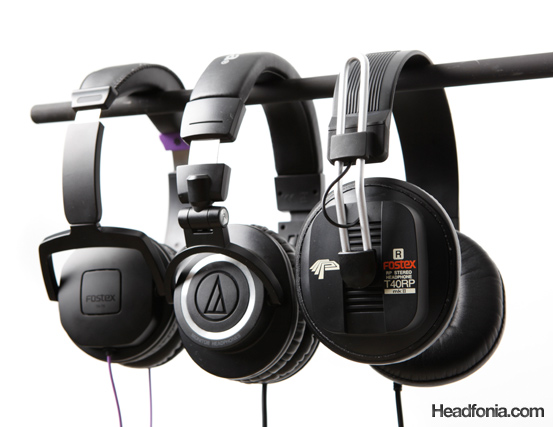
The housing size is fairly big. Here are a size comparison with the Fostex TH-7B, Audio Technica M-50, and the Fostex T40RP Mk2. The T50RP is identical in housing size to the T40RP Mk2.
Now that you’ve gotten an idea of where the T50RP stands roughly in the big headphone landscape, I’m going to tell you why this headphone is worth owning, because somehow, within the limitations of the T50RP, it doesn’t prevent me from getting drawn to the sound of the headphone.
As I said earlier, the T50RP is about a smooth grainless sound, and a deep black background. You’re not going to find a sparkly treble, punchy tight bass, or a massive soundstage with this headphone. If you find it difficult to understand what a grainless sound or deep black background is, it’s because they are rarely mentioned in headphone reviews. Indeed these are minor things we’re talking about (compared to tight punchy bass or a deep soundstage), but the Fostex pulled it off so successfully that I can’t seem to get enough of the T50RP’s sound. To put things into perspectives, dynamic drivers are almost always grainier (even the Sennheiser HD800) than what you get with the T50RP. Some of the less grainy dynamics are the Audio Technica M-50 and the Ultrasones, but the average Beyerdynamics, AKG, Audio Technica, or Sennheiser headphones are always grainy sounding cans. I don’t know if this is a function of the T50RP driver simply being better hence less grain, or if it’s the case of the Dynamic driver resolving grain in the source and amplifier (I’ve listened to the HD800 out of a Lehmann Black Cube and a Blacknote 3000 CD Player and it was quite grain free. Likewise the HD800 out of the Manley Neo-Classic 300B amplifier is very grain free). Nevertheless, the grain free sound is something that I rarely experience out of a dynamic set up, but the Fostex manages to give it to me on any set up I use.
The same grain-free and black background sound can be found in most Stax models (though I find the original Stax Lambda to be slightly grainy, likewise the original Fostex T50v0). When comparing the T50RP to the Stax Lambda frame models, obviously the closed circumaural T50RP feels noticeably closed than the Lambdas, but on the other hand I find the T50RP’s sound to have a more proper weight on the low end as well as a more linear midrange-treble area than the Staxes. Although the Lambda frames ultimately would sound more luxurious and spacious (hence a typical Stax Lambda system sells for more than $500), the Fostex again remains quite unique in itself, and I can see how some people would prefer the Fostex to a Lambda system.
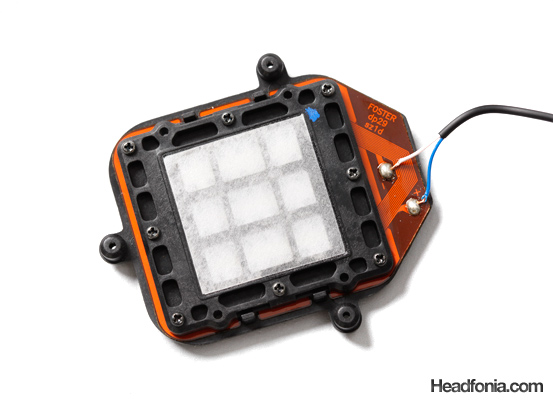
Both models come with the same driver.
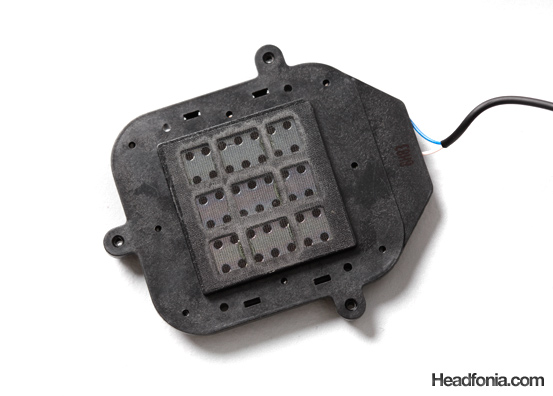
The other side of the driver.
The T50RP was made to be a supposedly flat-line studio headphone, and although most dynamic headphones voiced that way tend to be flat and boring, the T50RP’s unique voicing is one of the most addictive headphones I’ve ever auditioned. It’s the headphone that makes me want to stick around my headphone testing room and play one more song just to hear them out of the Fostex.
Due to the relatively flat tonal balance, you’re not going to get the kind of pleasing coloration that you’d get from say a Sennheiser headphone, or the sparkly treble and clarity out of a Beyerdynamic. The PRaT factor is also moderate, as each bass punch is just enough to tell you that the microphones have indeed captured them. Worth mentioning is the way the treble smoothly extends to top frequencies, making a very relaxed listening experience while still maintaining a good extension. But the most special aspect of the T50RP is its presentation of the vocals. Good presence and intimacy, but the T50RP’s moderately relaxed stance keeps the vocal in an unoffensive stance, making for a very relaxed long term listening session. The mood is just perfect for Indie stuff like Mumford and Sons, Belle and Sebastian, or She and Him. Any music with a cool and relaxed attitude seems to play very well with the T50RP, and as of now it may be the best headphone I’ve found for listening to Beatles’ Remastered albums. When I try playing alternative Rock with the T50RP, I feel that the attack on the music has been numbed and the snap a little rubbery. Although it makes for a quite unique presentation, I would gladly recommend something like the Alessandro MS1i or the Sennheiser HD25-1 as you get a better attack and energy on those cans.
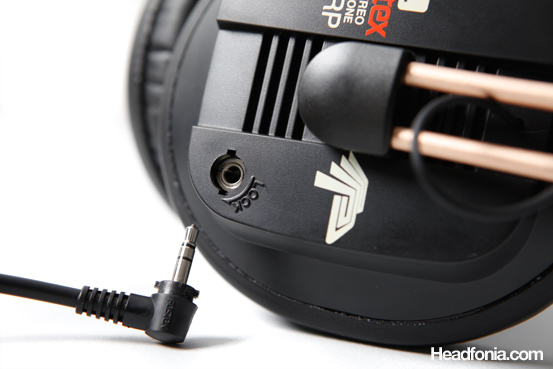
Removable cables with locking mechanism.
T40RP MK2 vs T50RP
The T40RP mk2 is a closed design model, also equipped with an orthodynamic driver. Positioned as one model below the T50RP, it’s similar to how the Sony ZX700 is to the Z1000. However, the drop in sound quality of the T40RP makes it a hard model to recommend to you guys. First of all the bass rolls off quite early and is not as deep as the T50RP. The midrange is also less composed, less weighty, and more honky than the T50RP. Overall the sound is clearly inferior and not as well composed as the T50RP. The housing reverbs are also more evident on the T40RP, adding a small amount of plasticky timbre compared to the T50RP. Well, at least the bass is not as boomy as what I remembered the T20RP Mk2 to sound.
Surprisingly all these difference comes from a simple differences in the housing. The T50RP’s drivers have openings on the slots, where the T40RP Mk2’s totally closed. Another difference is a slight change of damping material positioned right behind the drivers.
Both Fostex orthos are relatively efficient and easier to drive than the Hifiman and Audez’e full size orthodynamics. An Ipod can do a decent job, but a Hifiman HM-601/602 have more than enough voltage swing for these orthos, likewise a simple entry level DAC/Amp box like the Audinst HUD-MX1.

Surprise, surprise. Same driver!
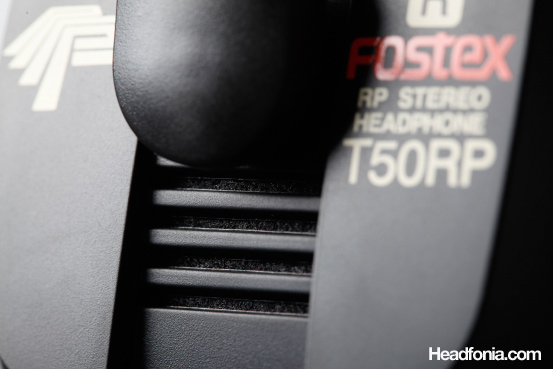
The slots are semi open on the T50RP. They are fully closed on the T40RP Mk2.
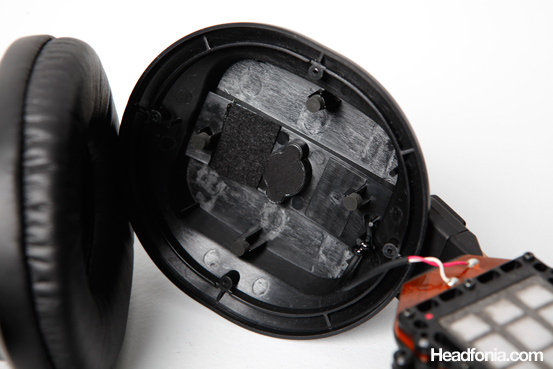
Differences in damping: pay attention to the small piece of felt cloth around the middle of the housing. This is the T50RP’s housing.
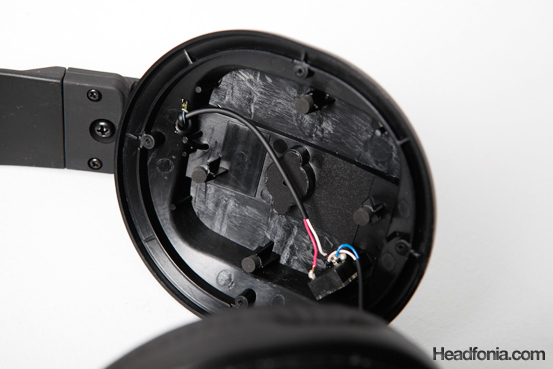
And this is the T40RP Mk2’s housing.
OTHER COMPARISONS (vs Audio Technica M-50, vs Fostex TH-7B)
The tonal balance and sound signature of the T50RP is very flat and unoffensive. This is a far as you can get from typical colored headphones like the Grados or the dark and laid back Sennheisers, and even the AKGs and the Beyers are not as flat sounding as the T50RP. When choosing for a headphone to compare the T50RP to, a headphone that come to mind is Fostex’s own TH-7B, a dynamic driver with similar voicing to the T50RP. Another one that I can think of is the Audio Technica M-50, a fairly linear dynamic headphone if we overlook the bass areas that sometimes get a little boomy.
In the dynamic world, the Audio Technica M-50 ranks fairly low on PRaT factor, as other less technical headphones like the Marhall Major or the relatively unknown Sennheiser PX90 easily does better PRaT than the M-50. However, with the Fostex T50RP, PRaT was totally non existant that it makes the fairly laid back Audio Technica M-50 a better Rock headphone when seen relative to the T50RP. I do not mean to attack the T50RP with that statement, but rather, I try to describe some of the principal differences between the two phones. Here is a headphone that presents all of the frequency ranges with such an inoffensive attitude that the M-50 can be seen as an agressive headphone when compared to the T50RP.
In the area of soundstage, the T50RP gave a much wider and deeper soundstage than what I’m hearing on the M-50. The three dimensionality was quite flat, and in that area the M-50 is better. But overall, the bigger soundscape, the more distinct separation, and the more laid back soundstage makes it a better tool for monitoring purposes or for playing live recorded Jazz. The relaxed presentation also makes it a better Jazz headphone than the M-50, though overall the M-50 is the more all-rounder headphone.
The voicing of the T50RP is also quite close to its dynamic sibling, the TH-7B that I reviewed earlier. But again the dynamic driver made a less flat presentation with a fuller bass body and a more evident upper treble that makes cymbals more lively. Though the soundstage is not as wide as on the T50RP, the TH-7B presents a deeper and more three dimensional image. Though I am a big fan of three dimensional soundstage, in this case my ears still prefer the T50RP by a significant margin. One reason is the more accurate timbre, but the midrange of the T50RP simply is better to my ears than the TH-7B’s.
END THOUGHTS
Hopefully I’ve done a good job in giving a picture of what the T50RP and T40RP sound is all about. Between the two models, the T50RP is definitely the one to go for. Both are fairly niche headphones, and rock listeners better stay away from them. However, I do think that there is a strong magic in the sound of the T50RP, and it’s definitely a very unique headphone that I would recommend to Jazz, Vocals, and Indie listeners.